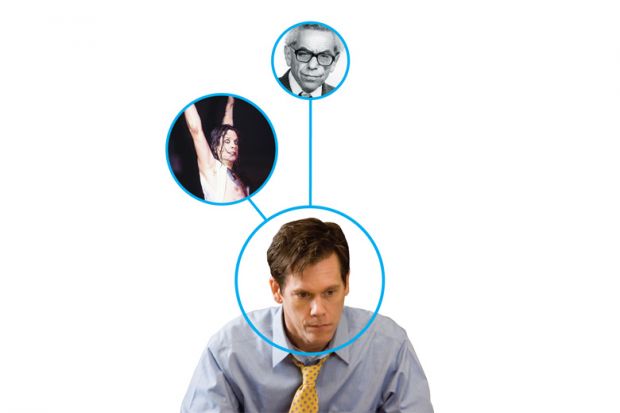Erdös-Bacon-Sabbath (EBS) numbers are in the news. To have one at all makes you a bit of a polymath. This is because you must have creative links to the mathematician Paul Erdös, the actor Kevin Bacon and the heavy metal music group Black Sabbath.
The mathematicians started it all. Paul Erdös, whose life is vividly described in The Man Who Loved Only Numbers, was a Hungarian mathematician who had no home, no job and not even a bank account. He simply moved between the homes of his mathematical colleagues, deriving theorems and writing joint papers – more than 1,500 of them, with 511 different collaborators. Some bright spark decided that each of these collaborators must have an Erdös (E) number of 1. Anyone who had published a paper with one of the collaborators (but not Erdös himself) would have an Erdös number of 2. And so on.
This was a fun game among pure mathematicians, but then along came “Six Degrees of Kevin Bacon”. This was a game invented by a group of college students, following a television interview in which Kevin Bacon commented that he had worked with everyone in Hollywood or with someone who’d worked with them. So the Bacon number came into being; if you are an actor who has performed with someone who has performed with someone who has performed with Kevin Bacon, for example, you would have a Bacon (B) number of 3.
Finally, along came the Black Sabbath (S) number, connecting musicians in the same way to the band Black Sabbath.
But what would it mean to have all three numbers? The TimeBlimp website came up with idea of a combined Erdös-Bacon-Sabbath number, supposedly accessible only to such multitalented individuals as have acting, music and mathematical sciences in their portfolio. There have turned out to be a surprisingly large number of such individuals. I decided to find out whether I was one of them.
Stephen Hawking is near the top, with a total EBS number of 8. (Did you know that he has performed with Pink Floyd?) How close could I come to matching him and some of my other scientific heroes?
As a scientist, I have worked with a number of mathematicians, even though I can’t rightly count myself among their number. (Once, when I incautiously revealed that I had a degree in pure mathematics, the mathematician with whom I was working at the time turned around in astonishment and said “YOU?!”) One of those with whom I worked was the Australian Barry Ninham, who has an Erdös number of 3. I haven’t published with Barry, but I have published with Jacob Israelachvili, who has published with him, so that gives me an Erdös number of 5.
Now for the hard bit, or so I thought. How on earth could I have a Bacon number? Well, I have appeared on the television quiz show Mind Games with Richard Hammond, who of course appeared with Jeremy Clarkson on Top Gear, while Clarkson appeared with Tom Hanks in Cars, and Hanks appeared with Bacon in Apollo 13. So that gives me a Bacon number of 4.
But wait! I have appeared on the BBC’s One Show, demonstrating the science of biscuit dunking, with Chris Evans, who has interviewed many actors who have acted with Kevin Bacon. Problem solved, and a Bacon number of 3.
The music bit seemed even more difficult, until I realised that I have actually sung (and the DVD of our performance in Bristol’s Colston Hall publicly released) with Stephen Taberner and the Spooky Men’s Chorale, from the Blue Mountains in Australia. I wrote to Stephen, begging for assistance. Did he have any connection with Black Sabbath? Indeed he did. He has sung with his good friend Tony Backhouse, who used to have a group called Mammal that performed with Black Sabbath in the 1970s. So, even though I am in no sense a muso (although maybe I am a better singer than Hawking), I have a Black Sabbath number of 3, and a total EBS number of 5+3+3=11.
Which, according to TimeBlimp, puts me in the company of Albert Einstein, Buzz Aldrin and Brian Cox. Who says that scientists aren’t polymaths?
As an addendum, I would suggest that a fourth number be added – an “I” number, signifying the number of links needed to establish a direct connection with an IgNobel prizewinner. There, at least, I would have a head start.
Len Fisher is visiting research fellow in the School of Physics, University of Bristol.




